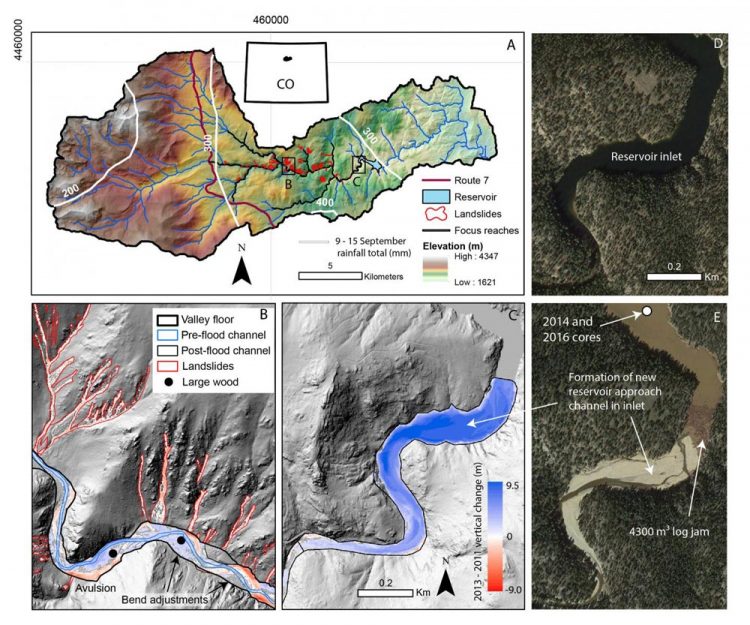More than 100 years of flooding and erosion in 1 event

Flood impacts in the North St. Vrain Creek catchment, northern Colorado, USA. Images in D and E are from Google Earth™
More than half of the eroded sediment was deposited at the inlet and delta of a water supply reservoir, resulting in the equivalent of 100 years of reservoir sedimentation and 2% loss in water storage capacity.
The flood discharged 28 mega-grams of carbon from one square kilometer of land (28 Mg C/km2), which is more like what would happen in humid, tectonically active areas.
To get an idea of what that means, Rathburn explains, a mega-gram of carbon (C) eroded from one square kilometer of land is equivalent to about a million paper clips covering an 18-hole golf course. So in this scenario, the flood discharged 28 million paper clips from just a golf course-sized area.
Post-flood remobilization resulted in a further ~100-years-worth of reservoir sedimentation plus export of an additional 1.3 mega-grams of carbon per square kilometer (1.3 Mg C/km2) of wood. Pronounced channel widening during the flood created accommodation space for 40% of flood sediment and storage of wood and eroded carbon. Confined channels, normally dismissed as transport reaches, can store and export substantial amounts of flood constituents.
The results of this study by Rathburn and colleagues indicate that many flood-affected Colorado Front Range rivers will export sediment, wood, and carbon for years to come, posing ongoing challenges for water-supply management, with implications for terrestrial carbon cycling.
###
ARTICLE
The fate of sediment, wood and organic carbon eroded during an extreme flood, Colorado Front Range, USA http://geology.
Authors: S.L Rathburn, G.L. Bennett, E.E. Wohl, C. Briles, B. McElroy, and N. Sutfin. Contact: Sara Rathburn, Colorado State University, Fort Collins, Colorado, USA, sara.rathburn@colostate.edu.
GEOLOGY articles are online http://geology.
Media Contact
All latest news from the category: Earth Sciences
Earth Sciences (also referred to as Geosciences), which deals with basic issues surrounding our planet, plays a vital role in the area of energy and raw materials supply.
Earth Sciences comprises subjects such as geology, geography, geological informatics, paleontology, mineralogy, petrography, crystallography, geophysics, geodesy, glaciology, cartography, photogrammetry, meteorology and seismology, early-warning systems, earthquake research and polar research.
Newest articles

First-of-its-kind study uses remote sensing to monitor plastic debris in rivers and lakes
Remote sensing creates a cost-effective solution to monitoring plastic pollution. A first-of-its-kind study from researchers at the University of Minnesota Twin Cities shows how remote sensing can help monitor and…

Laser-based artificial neuron mimics nerve cell functions at lightning speed
With a processing speed a billion times faster than nature, chip-based laser neuron could help advance AI tasks such as pattern recognition and sequence prediction. Researchers have developed a laser-based…

Optimising the processing of plastic waste
Just one look in the yellow bin reveals a colourful jumble of different types of plastic. However, the purer and more uniform plastic waste is, the easier it is to…



